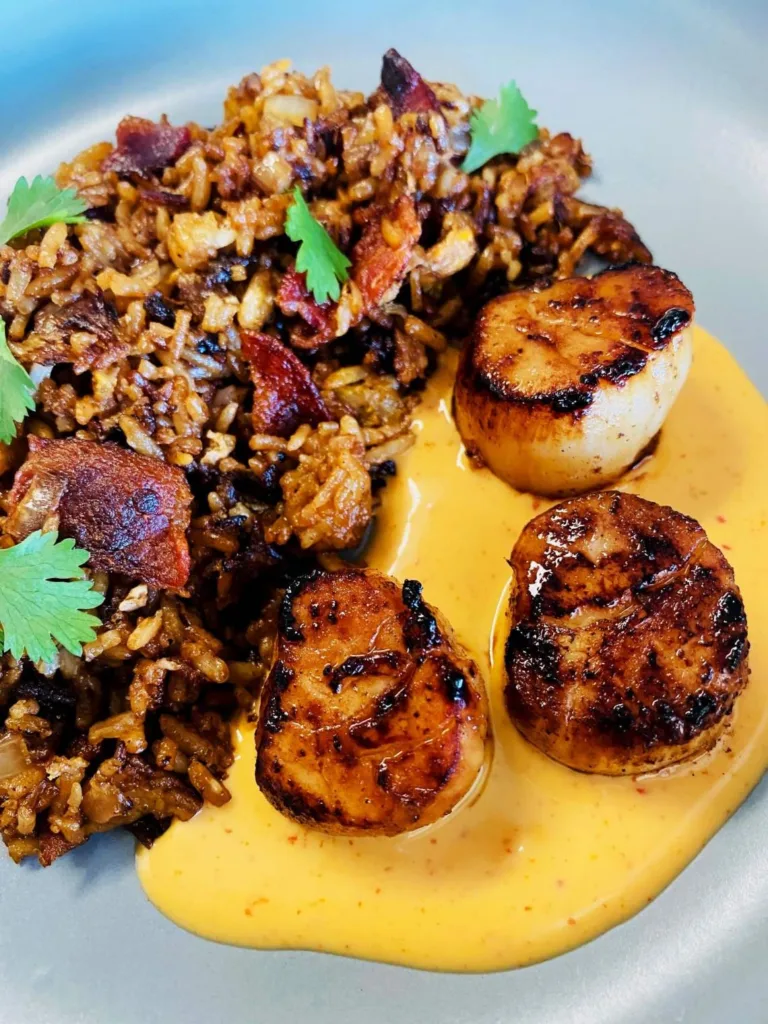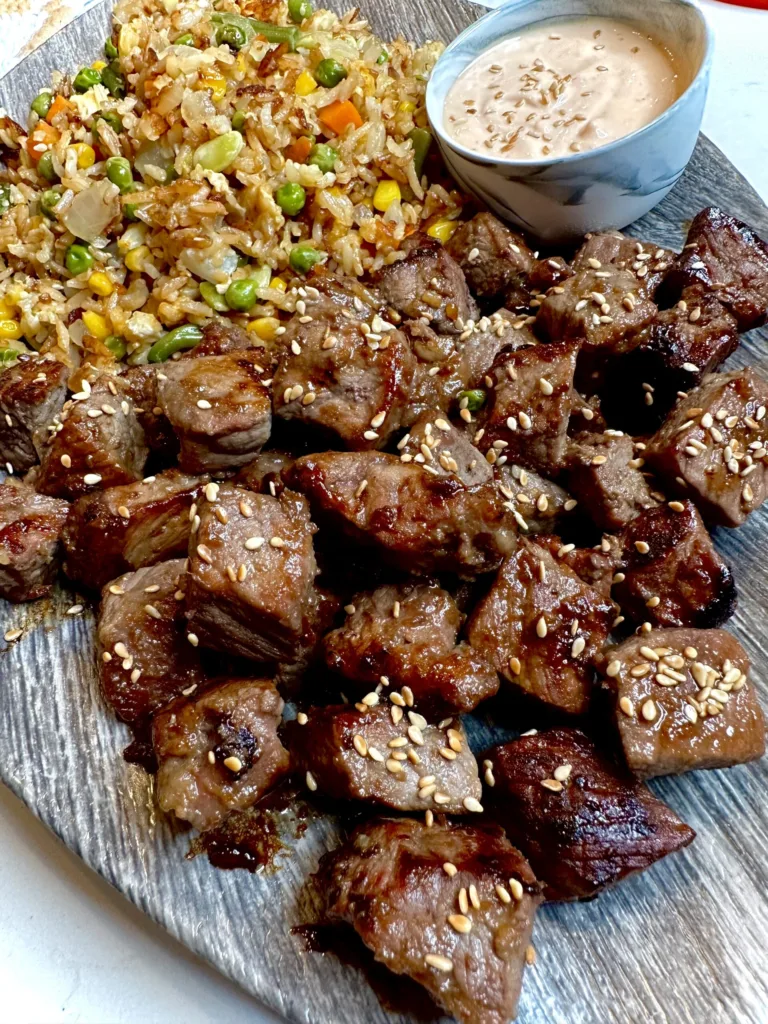When it comes to Japanese cuisine, hibachi-style grilling is a popular choice for many people. The combination of savory meats, vegetables, and rice makes for a delicious meal that is sure to satisfy any appetite. But the question remains: is hibachi healthy?
The answer is not a simple one. It depends on what you choose to eat and how it is prepared. For example, if you choose to indulge in the fatty cuts of meat, such as beef or pork, your meal will likely be high in calories and saturated fat. However, if you opt for leaner options like chicken or seafood, you can still enjoy a healthy meal.
Another factor to consder is how the food is prepared. Hibachi-style meals are often cooked with butter, oil, and sweet sauces, which can quickly raise the calorie and fat content of the dish. However, some hibachi restaurants offer healthier options, such as cooking the food with less oil or substituting a heavier sauce with a lighter one.
When it comes to sides, hibachi restaurants often offer a variety of options, including vegetables and rice. Choosing these sides over fried options like tempura or mozzarella sticks can help make your meal healthier.
So, overall, is hibachi healthy? It depends on what you choose to eat and how it is prepared. If you choose leaner meats, opt for healthier cooking methods, and choose healthier sides, you can enjoy a healthy hibachi meal. However, if you indulge in fatty meats, fried sides, and heavy sauces, your meal will likely be less healthy.
It is up to the individual to make healthy choices when dining at a hibachi restaurant. With careful consideration and moderation, hibachi can be a delicious and healthy meal option.
Healthiest Options at Hibachi
When it comes to dining at a hibachi grill, there are a number of factors to consider in order to choose the healthiest option. Here are some tips to keep in mind:
1. Choose lean protein: The type of meat you order is important. Chicken, fish, and shrimp are all healthy options, as they are lean sources of protein. Beef is not as lean, but you can opt for a leaner cut of beef to reduce the amount of saturated fat you consume.
2. Load up on vegetables: Hibachi grills are typically known for their delicious stir-fried vegetables. Take advantage of this and order a variety of vegetables to accompany your protein. This will add fiber, vitamins, and minerals to your meal, making it even healthier.
3. Watch the sauces: Many hibachi dishes are served with sauces that can be high in sodium, sugar, and calories. Be mindful of the amount of sauce you consume, and ask for it on the side so you can control how much you use.
4. Skip the fried rice: While fried rice is a popular option at hibachi restaurants, it is not the healthiest choice. Opt for steamed rice instead, or even better, ask for brown rice if it is available.
5. Go easy on the alcohol: If you plan on having a drink with your meal, keep in mind that alcohol is high in calories and can add up quickly. Stick to one drink, or skip the alcohol altogether and opt for water or unsweetened tea instead.
By following tese tips, you can make a healthier choice when dining at a hibachi grill. Remember to choose lean protein, load up on vegetables, watch the sauces, skip the fried rice, and go easy on the alcohol.

The Unhealthiness of Hibachi
Hibachi-style meals are a popular choice at many restaurants, but they are often high in fat and calories, making them an unhealthy option for those watching their diet.
One of the main factors that contribute to the unhealthiness of hibachi-style meals is the way they are prepared. These dishes are typically cooked on a grill, which means they are often cooked with large amounts of butter or oil. This can quickly increase the calorie and fat content of the meal.
In addition to the high amounts of fat used in cooking, hibachi-style meals also tend to be served with a sweet sauce. These sauces are often high in sugar and calories, which can further contribute to the unhealthiness of the meal.
Another factor that makes hibachi unhealthy is the ingredients used in the dish. Many hibachi-style meals are made with beef, chicken, or seafood, which are all high in fat and calories. These ingredients are often combined with eggs, vegetables, and rice, which can also add to the calorie count.
To make matters worse, hibachi-style meals are often served in large portions, which can lead to overeating and weight gain. This is especially true if the meal is accompanied by appetizers, drinks, or desserts.
Hibachi-style meals are unhealthy bcause they are often prepared with large amounts of fat, served with sweet sauces, made with high-calorie ingredients, and served in large portions. If you are looking to eat healthily, it is best to avoid hibachi-style meals or choose lighter options when dining out.
Calorie Count of Hibachi Dishes
Hibachi is a popular style of Japanese cuisine that involves grilling meat, seafood, and vegetables on a flat-top grill. While hibachi dishes can be delicious and satisfying, they can also be high in calories.
The exact number of calories in a hibachi meal can vary depending on the specific ingredients used and the portion size. However, hibachi dishes often contain large amounts of rice, noodles, and oil, whih can contribute significantly to the calorie count.
For example, a typical hibachi steak dinner can contain upwards of 1500 calories, with most of these calories coming from the rice and noodles. This is roughly equivalent to the number of calories in a full day’s worth of food for many people.
If you are watching your calorie intake, it may be a good idea to limit your consumption of hibachi dishes or choose lower-calorie options such as grilled vegetables or lean protein sources like chicken or shrimp. It is also important to pay attention to portion sizes and to limit your intake of high-calorie sauces and condiments.
Hibachi dishes can be high in calories due to their use of rice, noodles, and oil. It is important to be mindful of portion sizes and to choose lower-calorie options when possible.
Is Hibachi Steak and Chicken a Healthy Choice?
Hibachi steak and chicken are popular dishes in Japanese cuisine that are often served in restaurants. While they can be delicious and satisfying, you may be wondering whether they are healthy or not.
The answer is that it depends on several factors, such as the cooking method, the ingredients, and the portion size. Here are some things to consider:
Cooking method:
Hibachi cooking involves grilling meat, seafood, and vegetables on a flat-top grill at high temperatures. This can result in a flavorful and crispy texture, but it can also lead to the formation of harmful compounds called heterocyclic amines (HCAs) and polycyclic aromatic hydrocarbons (PAHs) when the meat is charred or overcooked. These compounds have been linked to cancer in animal studies, but their effects on humans are still unclear. To reduce your exposure to HCAs and PAHs, you can ask the chef to cook your meat and vegetables for a shorter time, use marinades or rubs with antioxidant-rich herbs and spices, and avoid eating the charred parts.
Ingredients:
The ingredients used in hibachi steak and chicken can also affect their healthfulness. For example, if the meat is marbled with fat or served with a creamy sauce, it can add extra calories, saturated fat, and sodium to your meal. On the othr hand, if the meat is lean and paired with vegetables, brown rice, or a salad, it can provide protein, fiber, vitamins, and minerals to your diet. To make your hibachi meal healthier, you can ask for less oil, salt, and sauces, and choose lean cuts of meat such as sirloin, chicken breast, or shrimp.
Portion size:
The portion size of hibachi steak and chicken can vary depending on the restaurant and the dish. Some portions can be oversized and contain more calories, sodium, and fat than you need in one meal. To avoid overeating, you can share a dish with a friend or take home leftovers, or you can order smaller portions or appetizers instead of entrees. You can also ask the chef to serve your meal on a smaller plate or bowl, or to pack half of it before bringing it to your table.
Hibachi steak and chicken can be healthy choices if cooked and served in a mindful way. By choosing lean cuts of meat, pairing them with vegetables and whole grains, and controlling your portion size, you can enjoy the taste and nutrition of hibachi without compromising your health.

Conclusion
Hibachi grill food can be healthy if you make the right choices. Opting for lean meats like chicken, fish, or shrimp and avoiding beef or fatty cuts is a good start. Additionally, choosing side dishes like vegetables and whole grains can help balance out the calorie and fat content of the meal. It’s important to keep in mind that hibachi-style meals are often prepared with added butter, oil, and sweet sauces, so moderation is key. By making smart choices and being mindful of portion sizes, you can enjoy a delicious hibachi meal that is both tasty and healthy.
